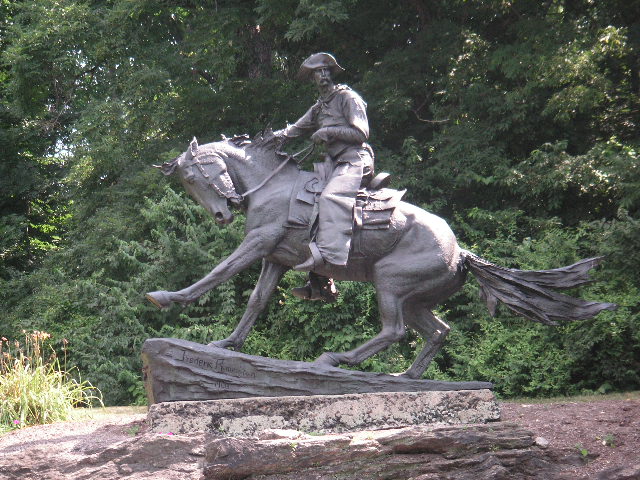Hallowed Bronze
September 30, 2010

The Cowboy, Frederic Remington
STATUES are living ghosts. They exist among us, frozen bronze and stone, silent and alive. This is the natural medium for heroes, the glorification of the individual and the sealing in stone of a spiritual narrative. No other art form depicts the important figures of the past in the same concrete, larger-than-life way. It is no wonder that the heroic statue is offensive to the contemporary sensibility, particularly the sensibility of the artist trained to be perpetually aggrieved and professionally stunned by the imperfections of warriors, political leaders, explorers and kings. Liberalism’s distrust of Western heritage and its suspicion of heroes is not conducive to affection for the bronze horseman or the marble saint. There must be some way to remove them from their pedestals, figuratively if not actually. The Metropolitan Museum put its paintings in storage during World War II to protect them. It would be too much to do the same here. But it would be nice if we could do something for these expressive artifacts in our parks and public squares. Perhaps the best we could do is collect them all in some safe warehouse until we are permitted to love our ancestors again.
— Comments —
N.W. writes:
I really can’t comment too much on defacing public statues because (to tie into two of your recent posts, ironically) I know somewhere out there is a photo taken around two hours past the Ides of March ’04 which shows the statue of Julius Caesar by the Roman Forum with a wreath around his neck and a Peroni bottle in his outstretched hand. No idea how it all got there.
J.P. Straley writes:
If you every have the opportunity, do visit Brookgreen Gardens in Myrtle Beach, South Carolina. It’s the kind of representative statuary you would enjoy, and the garden setting is quite remarkable.
Brookgreen was one of the original outer banks rice plantations in pre-revolutionary SC, and the first plantation owners planted a substantial formal garden. Now, there is an oak alley of 300-year old live oaks that is truly magnificent.
Worth seeing if you are in the area, and an ironic contrast to the cultural wasteland of vacation-land commercial Myrtle Beach. However, Huntington Beach State Park is just across US 17 from the Brookgreen entrance, and it is a lovely seashore.
Eric writes:
Seattle has a famous statue, Waiting for the Interurban, that is constantly ‘decorated’ with trash …

Laura writes:
“Waiting for the Interurban” is an example of democratic statuary. It doesn’t depict heroes, but the Common Man, sometimes faceless, but always generic and bland. George Segal popularized this kind of statuary. It has its own modest virtues; it can be witty and surprising, but defacing a Common Man statue is not the same as making Queen Victoria look like a clown. Generally, I find those anonymous figures chilling. Who wants more cold anonymity while walking through city streets? Okay, so we are all just cogs in the machine, with our pathetic brief cases and umbrellas. Enough, already.
Fred writes:
Yes, statues of admirable people in public places are important.
Our parks are democratic places, open to all. We can view our heroes with respect or with gentle mockery.
